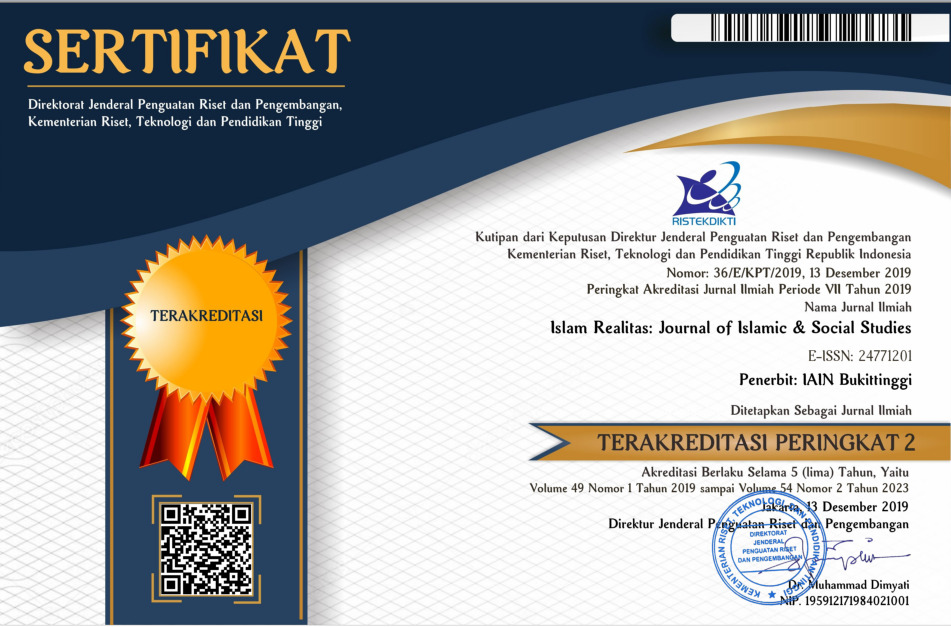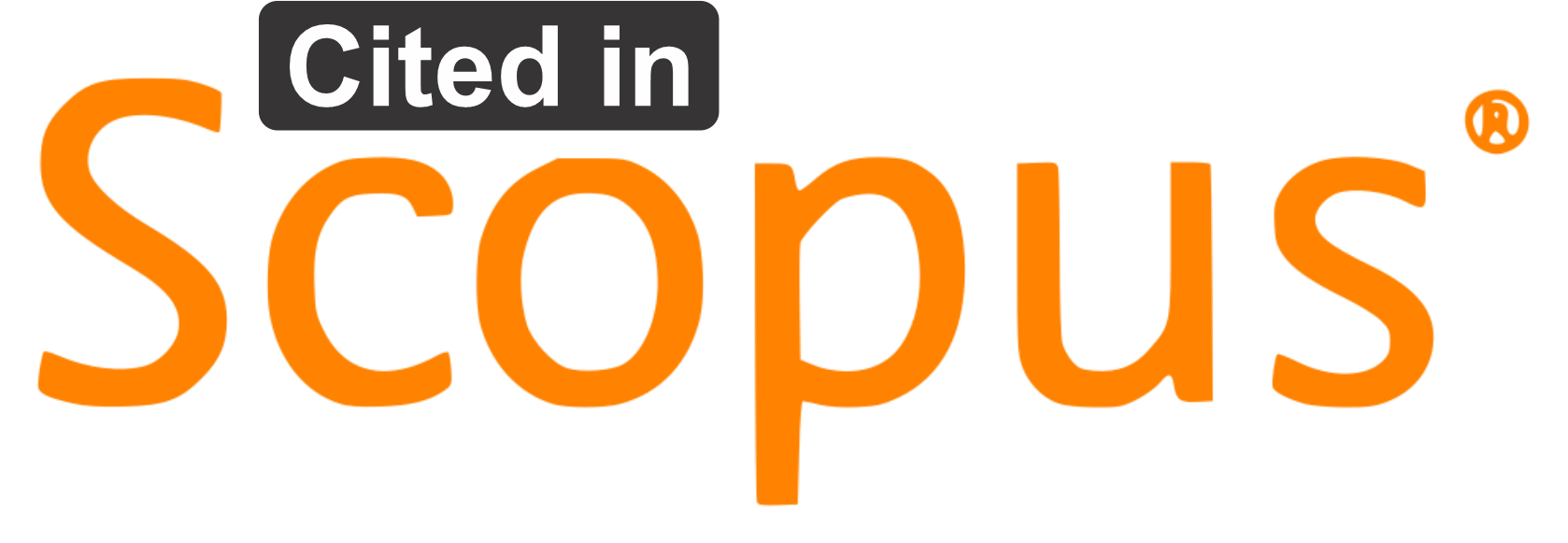Social Cohesivity of The Indonesian Muslim Community During the Ramadan
Downloads
Books
Buitelaar, Marjo, Fasting and Feasting in Marocco : Women’s Participation in Ramadan (Oxford, Berg, 1993)
Durkheim, Emile, The Division of Labor in Society (Roble Offset Printers, 1933)
Hellman, Jorgen, Ritual Fasting on West Java Empowerment, Submission, and Control (Swedia: Acta Universitatis Gothoburgensis, 2006)
Jenson, Jane, Mapping Social Cohesio: THe Satte of Canadian Research (Renouf Publishing Co. Ltd., 1998)
Kanaris, Jim, Bernard Lonergan`s Philosophy of Religion: From Philosophy of God to Philosophy of Religious Studies (State University of New York Press, 2002)
Kuntowijoyo, Paradigma Islam: Interpretasi Untuk Aksi, ed. by A.E Priyono (Bandung: Mizan, 1993)
Maxwell, Judith, Social Dimensions of Economic Growth (Department of Economics, University of Alberta, 1996)
Moller, Ramadan in Java: The Joy and Jihad of Ritual Fasting (Department of History and Anthropology of Religions, Lund University, 2005)
OECD, Perspectives on Global Development 2012. Social Cohesion in A Shifting Word (OECD Publishing, 2011) <http://www.oecd-ilibrary.org/development/perspectives-on-global-development-2012_persp_glob_dev-2012-en>
OECD, Social Cohesion in a Shifting World, Perspectives on Global Development 2012, 2012 <https://doi.org/10.1787/persp_glob_dev-2012-en>
OECD, Strengthening Social Cohesion in Korea: In Strengthening Social Cohesion in Korea, 2013th edn (OECD, 2013) <https://doi.org/10.1787/9789264188945-en>
Peters, Ina., Cohesion and Fragmentation in Social Movements : How Frames and Identities Shape the Belo Monte Conflict, 2017
Shalihin, Nurus, Demokrasi Di Nagarinya Para Tuan, ed. by Muhammad Sholihin (Padang: Imam Bonjol Press, 2014)
Journals
Akay, Alpaslan, Gökhan Karabulut, and Peter Martinsson, “The Effect of Religiosity and Religious Festivals on Positional Concerns: An Experimental Investigation of Ramadan,†Institute for the Study of Labor (IZA), 45.27 (2011), 1–25 <https://doi.org/10.1080/00036846.2012.736944>
Antoun, Richard T., “The Social Significance of Ramadan in an Arab Village,†The Muslim World, 58.2 (1968), 95–104 <https://doi.org/10.1111/j.1478-1913.1968.tb02709.x>
Bhardwaj, Pooja, “Types of Sampling in Research,†Journal of the Practice of Cardiovascular Sciences, 5.3 (2019), 157 <https://doi.org/10.4103/jpcs.jpcs_62_19>
Bialkowski, Jedrzej, Ahmad Etebari, and Tomasz piotr Wisniewski, “Piety and Profits: Stock Market Anomaly during the Muslim Holy Month,†University of Canterbury, Department of Economics and Finance, 52, 2010
Blankinship, Khalid Yahya, “Andrew Rippin, Muslims: Their Religious Beliefs and Practices,†International Journal of Middle East Studies, 28.3 (1996), 422–23 <https://doi.org/10.1017/S0020743800063558>
Botterman, Sarah, Marc Hooghe, and Tim Reeskens, “One Size Fits All? An Empirical Study into the Multidimensionality of Social Cohesion Indicators in Belgian Local Communities,†Urban Studies, 49.7 (2012), 185–202 <https://doi.org/10.1177/0042098010397397>
Campante, Filipe, and David Yanagizawa Drott, “Does Relegion Affect Economic Growth and Happines? Evidence From Ramadan,†Quarterly Journal of Economics, 57, 2015, 615–58 <https://doi.org/10.1093/qje/qjv002.Advance>
Carrasco, Maria A., and Usama Bilal, “A Sign of The Times: To Have or to Be? Social Capital or Social Cohesion?,†Social Science and Medicine, 159.April (2016), 127–31 <https://doi.org/10.1016/j.socscimed.2016.05.012>
Chan, Joseph, Ho-Pong To, and Elaine Chan, “Reconsidering Social Cohesion: Developing a Definition and Analytical Framework for Empirical Research,†Social Indicators Research, 75.2 (2006), 273–302 <https://doi.org/10.1007/s11205-005-2118-1>
Dickes, Paul, Marie Valentova, and Monique Borsenberger, “A Multidimensional Assessment of Social Cohesion in 47 European Countries,†Methodology, July, 2011, 11
Farmer, Melissa A., Paul D. Trapnell, and Cindy M. Meston, “The Relation Between Sexual Behavior and Religiosity Subtypes: A Test of the Secularization Hypothesis,†Archives of Sexual Behavior, 38.5 (2009), 852–65 <https://doi.org/10.1007/s10508-008-9407-0>
Forrest, Ray, and Ade Kearns, “Social Cohesion, Social Capital and the Neighbourhood,†Urban Studies, 38.12 (2001), 2125–43 <https://doi.org/10.1080/00420980120087081>
———, “Social Cohesion, Social Capital and The Neighbourhood,†Urban Studies, 38.12 (2001), 2125–43
Gazi, Abdul Karim, “The Social Impacts of the Holy Fast of Ramadan in the Context of Bangladesh: A Content Analysis,†Journal of Halal Studies, 1.1 (2020), 27–33 <https://www.researchgate.net/publication/343253884>
Govindaraju, Rajesri, Krisna Putra, Enrico Franz, Felix Erler, Tino Langer, Andreas Schlegel, and others, “Potensi Zakat Sebagai Pilar Perekonomian Umay Pasca Berlakuknya UU Nomor 38 Tahun 199 Tentang Pengelolaan Zakat (Studi Pengelolaan Akat Di Kabupaten Kendal),†Procedia Manufacturing, 30.22 Jan (2007), 588–95
Harell, Allison, and Dietlind Stolle, “Reconciling Diversity and Community? Defining Social Cohesion in Developed Democracies,†Contemporary Theoretical Perspectives on the Study of Social Cohesion and Social Capital, May, 2011, 15–46
Hellman, “The Significance of Eating During Ramadan: Consumption and Exchange of Foof in a Village in West Java,†Food and Foodways, 16.3 (2008), 201–26 <https://doi.org/10.1080/07409710802304176>
Kasmo, Mohd Arip, Bayu Taufiq Possumah, Zulkifli Mohamad, Wan Zulkifli Wan Hassan, and Nasruddin Yunos, “The Role of Religion in Social Cohesion within the Contemporary Muslim Society in Malaysia: Revisited,†Mediterranean Journal of Social Sciences, 2015 <https://doi.org/10.5901/mjss.2015.v6n1s1p168>
Kendler, Kenneth S., Xiao-Qing Liu, Charles O. Gardner, Michael E. McCullough, David Larson, and Carol A. Prescott, “Dimensions of Religiosity and Their Relationship to Lifetime Psychiatric and Substance Use Disorders,†American Journal of Psychiatry, 160.3 (2003), 496–503 <https://doi.org/10.1176/appi.ajp.160.3.496>
Khan, Muhammad Muzaffar Ali, Noraisha M.Nor, Nik Mazla Mamat, Nor Azwani Mohd-Shukri, and Wan Azdie Mohd Abu Bakar, “Fasting in Islam: A Combination of Spiritual Elevation and Prevention of Diseases,†International Medical Journal Malaysia, 17.2 (2016), 107–12
Makmun, Sukron, “The Fasting of Ramadan: Forming Positive Personal Character,†Humaniora, 7.3 (2016), 405 <https://doi.org/10.21512/humaniora.v7i3.3594>
Moller, Andre, “Islam and Traweh Prayers in Java,†Anpere, 2006, 1–20
Möllering, Guido, “The Nature of Trust: From Georg Simmel to a Theory of Expectation, Interpretation and Suspension,†Sociology, 35.2 (2001), 403–20 <https://doi.org/10.1017/S0038038501000190>
Moody, James, and Douglas R. White, “Social Cohesion and Embeddedness: A Hierarchical Conception of Social Groups,†American Sociological Review, 68.February (2003), 103–27
Mukherjee, Protap, and Lopamudra Ray Saraswati, “Levels and Patterns of Social Cohesion and Its Relationship with Development in India: A Woman’s Perspective Approach,†Centre for the Study of Regional Development, School of Social Siences, Jawaharlal Nehru University, New Delhi., 2006, 1–20 <http://www.oecd.org/development/pgd/46839502.pdf%0Apmukherjee25@gmail.com and rs.lopamudra@gmail.com>
Odabasi, Yavuz, and Metin Argan, “Aspects of Underlying Ramadan Consumption Patterns in Turkey,†Journal of International Consumer Marketing, 21.3 (2009), 203–18 <https://doi.org/10.1080/08961530802202891>
———, “Aspects of Underlying Ramadan Consumption Patterns in Turkey,†Journal of International Consumer Marketing, 21.3 (2009), 203–18 <https://doi.org/10.1080/08961530802202891>
Otte, Hanka, “Bonding or Bridging? On Art Participation and Social Cohesion in a Rural Region of the Netherlands,†Poetics, 76 (2019), 101355 <https://doi.org/10.1016/j.poetic.2019.02.006>
Pandita, R, “Ramadan: The Holy Month of Fasting,†Spade-a-Spade, 7.8 (2016), 17–18 <https://scholar.google.com/citations?view_op=view_citation&hl=en&user=FjgjthoAAAAJ&pagesize=100&citation_for_view=FjgjthoAAAAJ:-FonjvnnhkoC>
Permata, Inda Mustika, Bima Jon Nanda, and Rifki Dermawan, “The Importance of Social Capital for Faith-Based Organizations in the New Normal Adaptation of West Sumatera,†Islam Realitas: Journal of Islamic and Social Studies, 7.1 (2021), 16–28 <https://doi.org/10.30983/islam_realitas.v7i1.3728>
Rajulton, Fernando, Zenaida R. Ravanera, and Roderic Beaujot, “Measuring Social Cohesion: An Experiment Using the Canadian National Survey of Giving, Volunteering, and Participating,†Social Indicators Research, 80.3 (2007), 461–92 <https://doi.org/10.1007/s11205-006-0011-1>
Salleh, Muhammad Syukri, “Religiosity in Development : A Theoretical Construct of an Islamic-Based Development,†International Journal of Humanities and Social Science, 2.14 (2012), 266–74
Schiefer, David, and Jolanda van der Noll, “The Essentials of Social Cohesion: A Literature Review,†Social Indicators Research, 132.2 (2017), 579–603 <https://doi.org/10.1007/s11205-016-1314-5>
Schielke, Samuli, “Being Good in Ramadan: Ambivalence, Fragmentation, and the Moral Self in Thr Lives of Young Egyptians,†JRAI: Journal of the Royal Anthropological Institute, 2009, 24–40 <https://doi.org/10.1002/9781444324402.ch2>
Schmidt, Leonie, “Urban Islamic Spectacles: Transforming the Space of the Shopping Mall During Ramadan in Indonesia,†Inter-Asia Cultural Studies, 13.3 (2012), 384–407 <https://doi.org/https://doi.org/10.1080/14649373.2012.689708>
Schnabel, Annette, and Florian Groetsch, “In God We Trust–The Role of Religion for Cohesion and Integration in Current European Societies,†European Journal of Cultural and Political Sociology, 1.4 (2014), 375–98 <https://doi.org/10.1080/23254823.2015.1057752>
Shah, S. M. Atiq Ur Rehman, and Syed Nisar Ahmed, “The Ramadan Effect on Stock Market,†European Academic Research, 1.11 (2014), 4712–20 <http://edition.cnn.com/specials/politics/2016-election>
Shalihin, Nurus, Firdaus Firdaus, Yulia Yulia, and Ujang Wardi, “Ramadan and Strengthening of the Social Capital of Indonesian Muslim Communities,†HTS Teologiese Studies / Theological Studies, 76.3 (2020) <https://doi.org/10.4102/hts.v76i3.6241>
Shalihin, Nurus, and Muhammad Sholihin, Narasi Filosofis Penemuan Teori Sosial Dan Ekonomi (Depok: Rajawali Pers, 2022)
———, “Ramadan: The Month of Fasting for Muslim and Social Cohesion—Mapping the Unexplored Effect,†Heliyon, 8.10 (2022), e10977 <https://doi.org/10.1016/j.heliyon.2022.e10977>
Shalihin, Nurus, Yulia, and Muhammad Sholihin, “The Other Side of Ramadan: Ramadan and Its Implication on Social Cohesion In West Sumatra and Yogyakarta,†Analisa; Journal of Social Science and Religion, 6.1 (2021), 79–94 <https://doi.org/10.18784/analisa.v6i01.1309>
Syambudi, Irwan, “Wapres Maruf Sebut Jogja Kota Paling Heterogen & Toleran, Faktanya?,†Tirto.Id, 2020 <https://tirto.id/wapres-maruf-sebut-jogja-kota-paling-heterogen-toleran-faktanya-euHc> [accessed 27 June 2023]
Yavuz, Nilgün, Burak Güriş, and Burcu Kıran, “The Month and Holy Days Effects on the Volatility of Trade Deficit: Evidence from Turkey,†Journal of Economic and Social Research, 10.2 (2008), 67–84
———, “The Month and Holy Days Effects on the Volatility of Trade Deficit: Evidence from Turkey,†Journal of Economic and Social Research, 10.2 (2008), 67–84
Zetter, Roger, David Griffiths, Nando Sigona, Don Flynn, Tauhid Pasha, and Rhian Beynon, “Immigration, Social Cohesion and Social Capital What Are the Links ?,†Oxford Brookes University, 2006
Authors who publish with this journal agree to the following terms:
- Authors retain copyright and grant the journal right of first publication with the work simultaneously licensed under a Creative Commons Attribution License that allows others to share the work with an acknowledgment of the work's authorship and initial publication in this journal.
- Authors are able to enter into separate, additional contractual arrangements for the non-exclusive distribution of the journal's published version of the work (e.g., post it to an institutional repository or publish it in a book), with an acknowledgment of its initial publication in this journal.
- Authors are permitted and encouraged to post their work online (e.g., in institutional repositories or on their website) prior to and during the submission process, as it can lead to productive exchanges, as well as earlier and greater citation of published work (See The Effect of Open Access).









